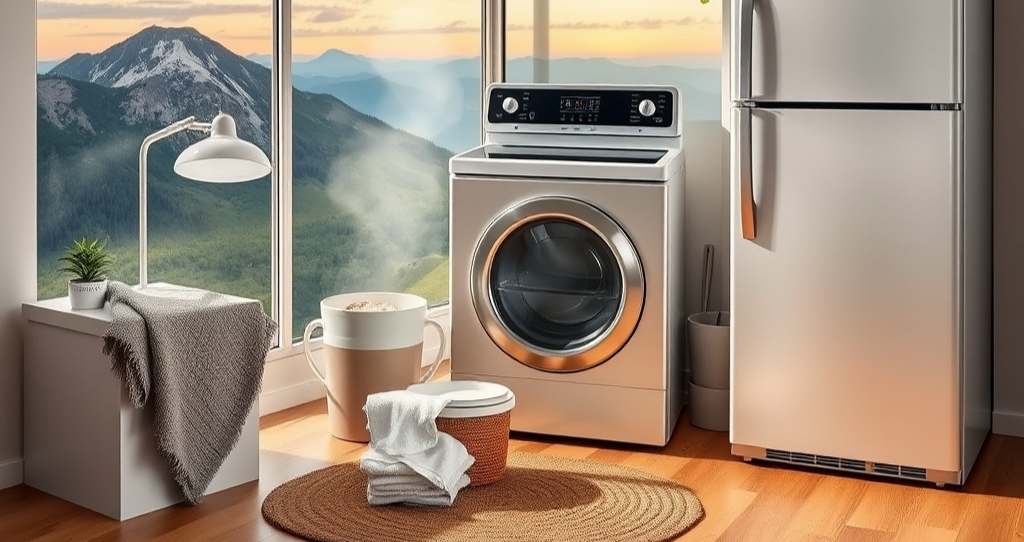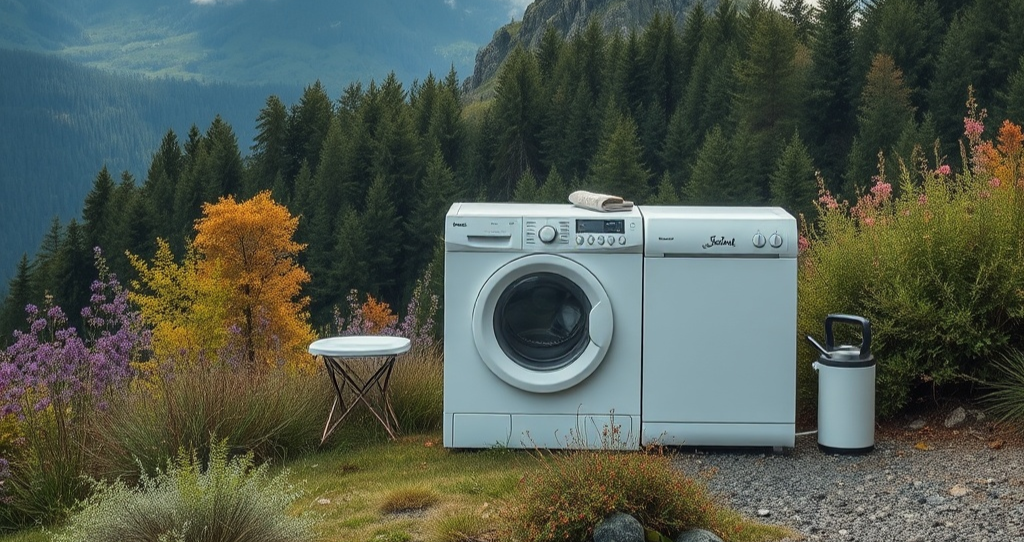Home appliances are the unsung heroes of our everyday lives Ultimate Guide to Cleaning and Maintaining 2024. These appliances like washing machines refrigerators ovens and dishwashers are designed to make our daily tasks easier. However to keep them functioning at their best proper cleaning and maintenance are essential. This guide will show you how to keep your household appliances clean and well-maintained so they last longer and work better.
Regular maintenance is key to saving time reducing energy consumption and avoiding costly repairs. In this guide you will find helpful information about various home appliances. It includes easy-to-follow instructions and useful tips to help you maintain your appliances and keep them working well.
Refrigerator Cleaning and Maintenance
The refrigerator is one of the most frequently used appliances in the home. It is essential for food preservation and operates continuously which makes proper maintenance crucial. Without regular cleaning your refrigerator can become inefficient use more energy and develop unpleasant odors.
Refrigerator Cleaning and Maintenance
The refrigerator is one of the most frequently used appliances in the home. It is essential for food preservation and operates continuously which makes proper maintenance crucial. Without regular cleaning your refrigerator can become inefficient use more energy and develop unpleasant odors.
Cleaning the Interior and Shelves
To keep your refrigerator clean and odor-free aim to clean it inside every three months. Follow these steps:
- Step 1: Unplug the Refrigerator: Remember to always disconnect the appliance from the power source before you start cleaning it. This ensures safety and prevents any electrical accidents.
- Step 2: Remove All Food Items: Take out all the food and throw away anything expired or spoiled. This is a good opportunity to reorganize and declutter.
- Step 3: Clean Shelves and Drawers: Remove all detachable shelves and drawers. To clean the items use warm water mixed with a gentle dish soap. If there are any tough stains a paste made from baking soda can help. After cleaning make sure to rinse everything well and then let it air dry.
- Step 4: Wipe Down the Interior: Clean the interior partitions with an answer of heated water and mild soap or vinegar. Remember to use a gentle cloth to clean all areas including the door and rubber seal. Make sure to clean any hard-to-reach spots where spills might have happened.
Maintaining the Coils Ultimate Guide to Cleaning and Maintaining 2024
Refrigerator coils play a critical role in keeping the appliance cool. If dirt and dirt construct up on those coils your fridge will work harder than it wishes to.
- Step 1: Locate the Coils: Coils are typically found either at the back or bottom of the fridge. Depending on the model you may need to unscrew a panel to access them.
- Step 2: Vacuum the Coils: Keep in mind the vacuum cleaner that has a brush attachment for cleaning the coils and eliminating dust and grime. You should do this every six months to make sure your machine works well.
- Step 3: Clean the Area Around the Coils: Once the coils are clean wipe down the area around them to prevent future dust accumulation.
Inspecting the Door Seals
Rubber seals on your refrigerator door are important because they keep the cold air inside and the warm air outside. If these seals are damaged.
- Step 1: Check for Damage: Inspect the seals for cracks or tears. If they are damaged replace them immediately.
- Step 2: Clean the Seals: Make sure to clean the seals by wiping them with warm soapy water and then drying them completely. If mold or mildew is present use a solution of vinegar and water to clean the area.
- Step 3: Test the Seals: To check if your door seals are working properly you can do a simple test. It means the seals are not tight enough and might need to be replaced.
Cleaning the Ice Maker and Water Dispenser
In case your fridge has an ice maker or water dispenser those additives also require regular renovation.
- Step 1: Remove and Clean the Ice Bin: Dump out any old ice and clean the bin with warm soapy water. Rinse and let it dry before replacing it.
- Step 2: Run a Vinegar Solution Through the Water Dispenser: To clean the water dispenser run a solution of vinegar and water through it.
- Step 3: Replace the Water Filter: Most refrigerators have water filters that need to be replaced every six months. Check the manufacturer recommendations for your model.
Dishwasher Cleaning and Maintenance
Dishwashers are invaluable for keeping our dishes clean but over time food particles grease and soap scum can build up inside the machine. Regular cleaning is essential to ensure your dishwasher runs smoothly and effectively.
Cleaning the Filter
Many dishwashers have a special filter at the bottom that catches small bits of food. If the filter becomes clogged the dishwasher will not clean dishes properly and may emit an unpleasant odor.
- Step 1: Remove the Bottom Rack: Slide out the bottom rack to access the filter.
- Step 2: Remove: Depending on your dishwasher model the filter may twist out or lift out. Please consult your user manual for instructions.
- Step 3: Clean the Filter: Soak the filter in warm soapy water. Let the product sit for 10-15 minutes and then use a soft brush to remove it. Any stuck-on debris. Rinse thoroughly before reinstalling it.
Removing Limescale Buildup
In areas with hard water limescale can build up inside the dishwasher reducing its efficiency and causing white spots on dishes.
- Step 1: Run an Empty Cycle with Vinegar: Place a cup of white vinegar on the top rack of the dishwasher and run a cycle with hot water. The vinegar will help to dissolve limescale buildup.
- Step 2: Use a Commercial Dishwasher Cleaner: If your dishwasher still has buildup after using vinegar try a commercial cleaner designed to remove limescale.
Cleaning the Spray Arms
The spray arms distribute water during the wash cycle. If the drains become clogged with food particles or mineral buildup. Deposits the dishwasher will not clean effectively.
- Step 1: Remove the Spray Arms: Many spray arms can be removed easily by unscrewing or unclipping them.
- Step 2: Clean the Spray Holes: Use a toothpick or a small brush to remove any blockages from the spray holes.
- Step 3: Soak the Spray Arms: Soak the spray arms in warm soapy soak the item in water for 15 minutes to remove any remaining residue. Rinse thoroughly and reattach them.
Maintaining the Door Gasket
The gasket around the door helps to prevent water from leaking during the wash cycle.
- Step 1: Clean the Gasket: Wipe down the gasket with warm soapy water paying special attention to the folds where dirt and debris can accumulate.
- Step 2: Inspect for Damage: If the gasket is cracked or torn replace it to prevent leaks.
Washing Machine Cleaning and Maintenance

Washing machines do a lot of heavy lifting when it comes to keeping our clothes clean but they also need regular maintenance to stay in top condition. A poorly maintained washing machine can lead to mold mildew and unpleasant odors.
Cleaning the Drum
Over time detergent residue and fabric softener can accumulate in the washing machine drum leading to dirt and debris buildup over time. Regular cleaning is essential to keep your clothes smelling fresh.
- Step 1: Transform cleansing cycle: To clean your washing machine Add 2 splash of white vinegar to the detergent dispenser and watch the magic happen as you run a hot water cycle. The vinegar will help to remove buildup and eliminate odors.
- Step 2: Wipe Down the Drum: After the cycle is complete wipe the drums inside Please use a clean cloth to wipe away any leftover residue.
- Step 3: Run a Second Cycle with Baking Soda: Get ready for some next-level freshness and cleanliness! Mixing 2 cup of baking soda to supercharge your drum deodorizing and cleaning routine.
Maintaining the Detergent Drawer
The detergent drawer can become clogged with residue mainly if you use liquid detergent or fabric softener.
- Step 1: Remove the Drawer: Pull out the detergent drawer and soak into the hot warm soapy water for 15 minutes.
- Step 2: Scrub the Drawer: Use a brush to remove any remaining detergent buildup. Rinse thoroughly and let it dry before replacing it.
Cleaning the Door Seal
Front-loading washing machines often have rubber door seals that trap moisture leading to mold and mildew growth.
- Step 1: Clean the Seal with Vinegar: Spray the door seal with vinegar and water and wipe it down with a cloth. Be sure to clean under the seal where water can collect.
- Step 2: Dry the Seal After Each Use: After every wash leave the door open to allow the seal to dry. This helps to prevent mold and mildew.
Maintaining the Lint Filter
Did you know that the majority of washing machines come equipped with a lint filter designed to capture debris from your clothes?
- Step 1: Locate the Filter: Refer to your user manual to find the location of the lint filter as it varies by model.
- Step 2: Remove and Clean the Filter: Remove the filter and rinse it under running water to remove lint and debris. To effectively remove stubborn buildup gently scrub the filter using a soft brush.
Oven Cleaning and Maintenance
Your oven is a kitchen workhorse but spills and splatters can build up over time affecting its performance and potentially leading to unpleasant smoke or odors. Keeping your oven clean will ensure it runs efficiently and cooks food evenly.
Cleaning the Oven Interior
The inside of the oven can become coated with grease food splatters and burnt-on residue. Keeping it clean is really important to make sure it works well.
- Step 1: Remove the Oven Racks: Do not forget to remove the shelves from the oven and let them soak in some warm soapy water.
- Step 2: Apply Oven Cleaner: If using a commercial oven cleaner follow the manufacturers instructions. For a natural solution apply baking soda and water to the interior surfaces and let it sit for 30 minutes.
- Step 3: Scrub and Wipe: To clean use a sponge or scrub brush to get rid of the cleaner and any leftover food. Then use a wet cloth to wipe the inside and make sure it is completely dry.
Maintaining the Heating Elements
The heating parts in an electric oven make the heat that cooks your food. If they get dirty or broken your oven does not cook your food evenly.
Step 1: Inspect the Elements: After using the oven it is important to turn it off and check the heating elements for any signs of damage such as cracks or discoloration.
Step 2: Clean the Elements: Remember to use a damp cloth to clean the stove burners. Please be gentle and avoid scrubbing too hard to prevent any damage.
Cleaning the Oven Door
The ovens glass door can become covered in grease and food splatters making it difficult to see inside while cooking.
Step 1: Remove the Door (if possible): Some oven doors can be removed for easier cleaning. Check your user manual for instructions.
Step 2: Clean the Glass: Utilize a glass cleaner or a blend of vinegar and water to wipe down both the interior and exterior of the door.
Step 3: Wipe and Dry: After cleaning wipe the door with a clean cloth and dry it thoroughly.
Maintaining the Oven Door Seal
Door seal traps heat while cooking which helps achieve perfectly even and efficient cooking of your food.
- Step 1: Inspect the Seal: Check the seal for any cracks or tears. If it is damaged replace it to ensure the oven retains heat.
- Step 2: Clean the Seal: Clean the seal using a moist cloth to eliminate any food debris or grease that might have built up.
Vacuum Cleaner Cleaning and Maintenance

Keeping your home clean and tidy is important and having a reliable vacuum cleaner can make the task much easier. free of dirt and dust but regular maintenance is required to keep it running at peak performance.
Emptying the Dustbin or Bag
Whether you have a bagged or bagless vacuum emptying the dustbin or replacing the bag regularly is essential.
- Step 1: Empty the Dustbin or Replace the Bag: If your vacuum is bagless empty the dustbin after every use or when it is two-thirds full.
- Step 2: Clean the Dustbin: Clean the dustbin the usage of heat soapy water to get rid of all of the dust and dust. Let it dry completely before putting it back on the vacuum.
Cleaning or Replacing Filters
Most vacuums have filters that trap dust and allergens.Over time these filters can get clogged which diminishes the vacuums suction power.
- Step 1: Remove the Filters: Please consult your manual to find and take out the filters.
- Step 2: Wash or Replace the Filters: keep your washable filters clean by washing them with warm water and mild soap. Let them dry completely before putting them back.
Maintaining the Brush Roll
Get ready to witness the incredible power of the brush roll on your vacuum. This amazing feature is designed to swiftly leaving your home sparkling clean.
- Step 1: Remove the Brush Roll: Most vacuums allow the removal of the brush roll for cleaning. Check your user manual for instructions.
- Step 2: Clean the Brush Roll: Please make use of scissors or a broom to cast off hair string and other debris from the brush roll.
- Step 3: Reinstall the Brush Roll: Once the brush roll is clean reinstall it according to the manufacturer’s instructions.
Checking for Clogs

Vacuum cleaners can become clogged with dirt hair and debris which can reduce suction and cause the vacuum to overheat.
- Step 1: Check the Hose
- Detach the hose and use a long flexible object to remove any clogs.
- Step 2: Clean the Nozzles and Attachments
- Remove any blockages from the vacuum nozzles and attachments reattaching.
Conclusion
Keeping your home appliances clean and well-maintained not only extends their lifespan but also ensures they run efficiently saving you time and money in the long run. From refrigerators to vacuum cleaners regular maintenance is key to preventing breakdowns and costly repairs. By following the detailed steps outlined in this guide you can keep your appliances running smoothly for years to come.
FAQs on Cleaning and Maintaining Home Appliances
Why is it important to clean and maintain home appliances regularly?
Regular cleaning and maintenance of home appliances help ensure they operate and efficiently have a longer lifespan. Proper maintenance reduces the risk of breakdowns saves energy and can even prevent potential safety hazards like electrical fires or water leaks.
How often should I clean my refrigerator?
Ideally you should clean the interior of your refrigerator every 3-4 months. Wiping down the shelves drawers and gaskets as well as cleaning the coils will help keep the refrigerator running efficiently and prevent bad odors.
What is the best way to clean a dishwasher?
To clean a dishwasher start by cleaning the filter running an empty cycle with vinegar to remove limescale and cleaning the spray arms. Also regularly check the door gasket for food particles and debris to avoid any water leakage.
How do I prevent mold and mildew in my washing machine?
To prevent mold and mildew always leave the washing machine and door open after each use to allow it to dry. Clean the rubber door seal regularly with vinegar and water to remove any trapped moisture and soap residue. Running a cleaning cycle vinegar or a commercial cleaner once a month also helps.
Can I use regular detergent to clean my oven?
While you can use mild dish soap for light cleaning for heavy grease or burnt-on food it is best to use a commercial oven and cleaner or homemade solution of baking soda and water.
How often should I clean or replace the vacuum and his cleaner filters?
The vacuum cleaners have a small filter and they should be cleaned or replaced every 3-6 months depending on the manufacturers recommendations. Washable filters should be rinsed with water while non-washable filters should be replaced as needed to maintain optimal performance.
How can I reduce energy consumption through appliance maintenance?
Regular maintenance such as cleaning refrigerator coils replacing filters in vacuum cleaners and descaling dishwashers helps appliances run more efficiently. This reduces energy consumption and can lower your electricity bills.
What is the best way to clean an oven without harsh chemicals?
A mixture of baking soda water might be used as a natural oven cleaner. Apply the paste to the ovens interior let it sit for several hours or overnight and then scrub and wipe it clean. Vinegar can also be sprayed to remove any lingering residue.
How do I maintain appliances like microwaves and coffee machines?
For microwaves wipe down the interior after each use and clean stubborn stains with a mixture of water and vinegar. For coffee machines run a cleaning cycle with vinegar to descale the machine and ensure it operates efficiently.
How can I tell if my appliance needs professional servicing?
As efficient as before or if signs of damage like electrical issues or frequent malfunctions show up it is a good idea to call a professional technician for servicing.
